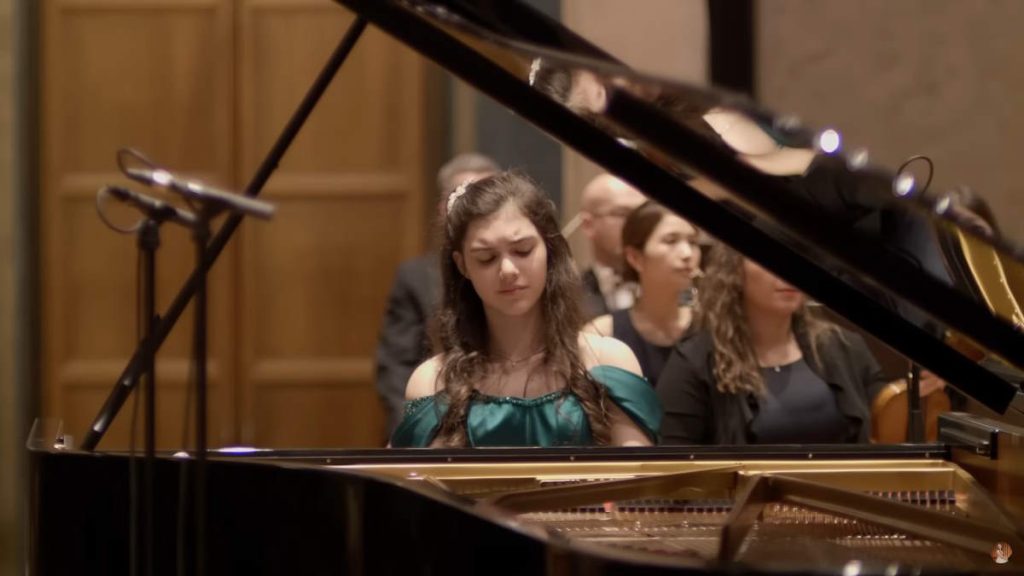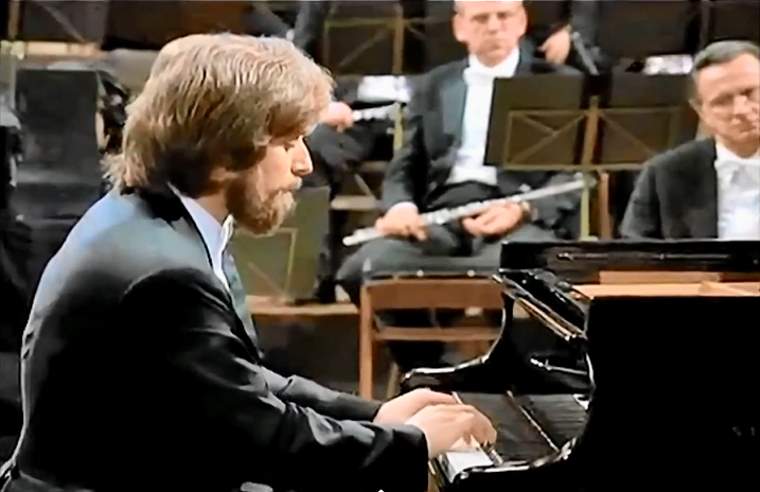Accompanied by the Orchestra of the Eighteenth Century, Maria João Pires performs Ludwig van Beethoven’s Piano Concerto No. 3 in C minor, Op. 37. Conductor: Frans Brüggen. Both Pires and the orchestra perform on period instruments. This performance was recorded on November 4, 2010, at the National Philharmonic Hall in Warsaw, Poland.
Beethoven’s Piano Concerto No. 3
Ludwig van Beethoven’s Piano Concerto No. 3 in C minor, Op. 37, is a significant work in the classical piano concerto repertoire. Composed between 1800 and 1803, it was premiered on April 5, 1803, with Beethoven himself as the soloist. This concerto marks a pivotal moment in Beethoven’s career, showcasing his transition from the Classical style of his predecessors, such as Mozart and Haydn, to his own distinctive and more dramatic Romantic voice.
The concerto is notable for its intensity and depth of expression, characteristics that are particularly evident in its bold and stormy C minor key. Beethoven’s choice of C minor, a key he often associated with dramatic and turbulent emotions, sets the tone for a work that explores a wide range of moods and colors. The interplay between the piano and orchestra is complex and sophisticated, with the soloist and ensemble engaging in a dynamic and often conversational relationship.
The piano writing in this concerto is virtuosic, demanding both technical prowess and expressive nuance from the performer. Beethoven’s own skills as a pianist influenced the concerto’s challenging passages and intricate dialogues between the piano and orchestra. The orchestration is rich and inventive, with Beethoven employing the full range of the orchestra to create a vivid and compelling musical narrative.
Movements
With start times in the video above:
- Allegro con brio 0:00
- Largo 17:30
- Rondo. Allegro 27:00
1. Allegro con brio
The first movement of Beethoven’s Piano Concerto No. 3 is marked “Allegro con brio”. It opens with a bold orchestral introduction that establishes the dramatic and intense character of the movement. The initial theme is powerful and assertive, setting a serious tone that is maintained throughout the movement. This orchestral exposition is extensive, presenting multiple themes and creating a rich musical tapestry before the soloist enters.
When the piano makes its entrance, it does so with a flourish, restating the main theme in a more elaborate and ornamented manner. The soloist and orchestra then engage in a dynamic interplay, with the piano often taking the lead but also seamlessly integrating with the orchestral textures. Beethoven’s writing for the piano in this movement is virtuosic and demanding, requiring both technical precision and expressive depth.
The development section of the movement explores and transforms the themes introduced in the exposition, with the music venturing through a variety of keys and moods. The piano and orchestra engage in complex dialogues, with Beethoven showcasing his innovative approach to thematic development and modulation. This section builds tension and excitement, leading to the recapitulation where the main themes return, now with added intensity and variation.
The movement concludes with a cadenza, typically improvised by Beethoven himself in performances. This cadenza is a showcase for the soloist’s virtuosity, allowing the pianist to explore and elaborate on the movement’s themes in a free and expressive manner. After the cadenza, the orchestra re-enters to bring the movement to a powerful and emphatic close.
2. Largo
The second movement of Beethoven’s Piano Concerto No. 3 is marked “Largo” and stands in stark contrast to the first movement’s intensity. This movement is in the key of E major, providing a serene and lyrical respite from the drama of the opening “Allegro con brio”.
The movement begins with a gentle and expansive theme introduced by the solo piano, characterized by its lyrical beauty and expressive depth. The melody is tender and contemplative, showcasing Beethoven’s ability to write music of profound emotional introspection. The slow tempo and flowing lines create an atmosphere of calm and introspection.
The orchestra soon joins the piano, and the interplay between the soloist and the ensemble is delicate and intimate. Beethoven’s orchestration in this movement is subtle and sensitive, with the orchestral instruments providing a soft and supportive background to the piano’s lyrical lines. The strings, woodwinds, and horns add color and texture to the movement, enhancing its overall warmth and serenity.
Throughout the movement, the piano continues to explore the main theme, embellishing it with delicate ornamentation and expressive nuances. The dynamic range remains generally subdued, with occasional crescendos that add emotional weight to the performance. The dialogue between the piano and orchestra is characterized by its grace and fluidity, creating a seamless and unified musical experience.
3. Rondo. Allegro
The third movement of Beethoven’s Piano Concerto No. 3 in C minor, Op. 37, is marked “Rondo: Allegro”. This movement brings a lively and energetic conclusion to the concerto, characterized by its spirited and dance-like qualities.
The movement is structured as a rondo, a form where the main theme (the refrain) alternates with contrasting episodes (the couplets). The main theme is introduced by the piano and is immediately recognizable for its rhythmic vitality and playful character. This theme is lively and engaging, with a buoyant, almost whimsical quality that showcases Beethoven’s inventive melodic writing.
The first episode follows, introducing new musical ideas that provide contrast to the main theme. These episodes often explore different keys and textures, creating a rich and varied musical landscape. The piano part is particularly demanding, requiring agility and precision to navigate the rapid passages and intricate figurations that Beethoven employs.
Throughout the movement, Beethoven maintains a dialogue between the soloist and the orchestra, with the piano often taking the lead but frequently engaging in a lively exchange with the orchestral instruments. This interplay adds to the movement’s dynamic and festive atmosphere.
One notable feature of this movement is Beethoven’s use of syncopation and unexpected accents, which contribute to its rhythmic drive and excitement. The movement also includes a brief cadenza, where the soloist has the opportunity to display virtuosity and bring a personal touch to the performance.
The rondo theme returns several times, each appearance bringing a sense of familiarity and cohesion to the movement. The final return of the main theme leads to a vigorous coda, where Beethoven ramps up the energy and excitement, driving the concerto to a thrilling and triumphant conclusion.
Sources
- Piano Concerto No. 3 (Beethoven) on Wikipedia
- Piano Concerto No. 3, Op.37 (Beethoven, Ludwig van) on the International Music Score Library Project website
- Ludwig van BEETHOVEN – Piano Concerto No. 3 on the L.A. Phil website
- Beethoven – Piano Concerto No.3 in C minor on the Classic FM website


